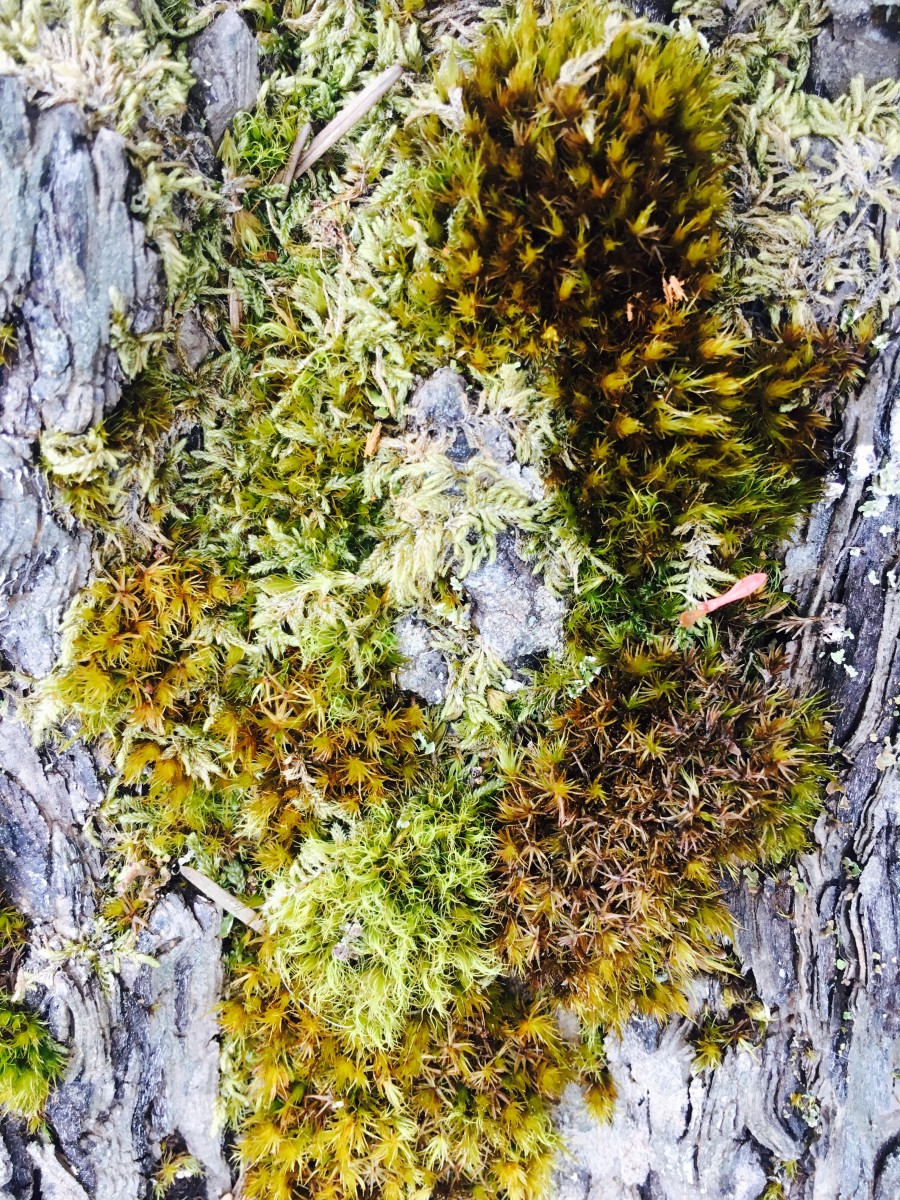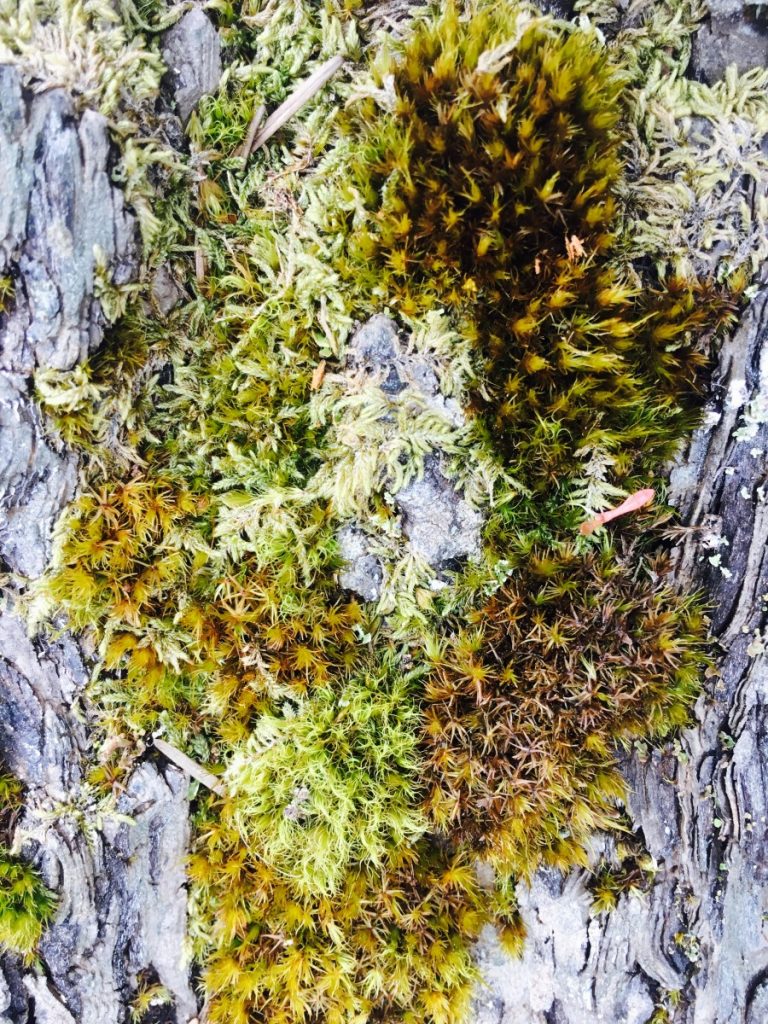For my second somatic exploration, I went alone to Capitol Forest to walk amongst the trees. I usually hike with my dog, but knew that her excitement, noise and (failed) attempts at chasing birds and squirrels would be a distraction. I chose what Google said was a 6 mile loop past Mima Falls, and set off from the parking lot into a chill, grey day. For the first while the path wound through what looked to be fairly recently logged forest. A legion of young fir trees grew all around the trail, no taller than myself. Scattered among them were the stumps of trees gone for new construction or paper mills. At one point three stumps sat clustered, just to the side of the trail. They called to me. I stopped, and sat on one of them. They still felt alive. According to Peter Wohlleben in The Hidden Lives of Trees, the mycelium network of fungi underground can carry chemicals and sugars between the roots of trees, and that younger trees will sometimes keep feeding the stumps of trees that are no longer living. They do this especially if that tree is somehow ‘related’ to them- if the stump was the tree that created the seed that gave them life. If that stump was their mother.
***
In reading The Handbook of Contemporary Animism, I was struck by the constant references to the ways that animistic indigenous cultures considered themselves as members of kin groups that included both human and more-than-human members. These kin groups were highly specific to the bioregion in which each culture arose; not a generic ‘love the earth’ messaging but a deeply felt, specific and practical relationship with the species around then upon whom they were dependent for survival. In the Victoria River region of Australia, Deborah Bird Rose lived with and studied a group of Aboriginal people who lived within kin lineages that included both humans and the species around them upon whom they lived in mutual dependency. In talking about one lineage of Dingo people, she says:
“They are responsible for the flourishing of dingoes in the world, and this means as well that they are responsible for their own flourishing (as Dingo people)… Dingoes (the animals) also have responsibilities toward them (the humans) but it is fair to say that as a human being one knows the most about human responsibilities” (140).
In Staying with the Trouble Donna Haraway changes the word “responsible” to “response-able” meaning, to whom are you able to have a response?
Sitting there with the three stumps, it was as if I could feel the ghost of the forest that had stood before, or maybe the ghost of the forest that was to come, the one that was growing. This wasn’t something that came from my imagination, it was something I could sense in the air. Like an eagerness and a sad remembering at once. Sitting on the stump I considered the fact that, at least in English, we don’t have any word for ‘death’ that doesn’t imply a complete end to existence. We would say that the tree whose stump I was sitting on died and in doing so we would be saying that that tree had ceased existing. All the more so to speak of the death of a more sentient (as far as we know or accept) creature such as a dog or a human. This conception of death leaves out the fact that while our consciousness might (probably, we can’t actually know) cease existing, all of the matter that made up our physical bodies goes on to become something else. For this tree maybe it was a house or paper, eventually to decompose into something else. For my body when I go, maybe parts of me will become plankton in the sea, or a spider, or grains of sand, or an eagle.
***
Another theme in the HCA was that of the permeability of self that exists in many animistic indigenous cultures. ‘Self’ is not a clearly delineated territory of property, with strong boundaries between the property (body) and the world, but something inhabited for a time within the matter that makes up all of life:
“Everywhere in the animic archipelago, one finds the same idea that vitality, energy and fecundity constantly circulate between organisms thanks to the capture, the exchange and the consuming of flesh. This constant recycling of tissues and fluids, analogous to the nutritional interdependence in the synecological process, is a clear indication that all these being who ingest one another cannot be distinguished by the substances they are made of.” (Descola, 80).
I am Kirsten, for now, because the matter that has come together in my form has also developed the consciousness that exists as myself, but in the end this matter will go on to be food for something else, just as all the pigs, salmon, broccoli and potatoes that I eat in this form have become a part of me.
The different conception of self between agrilogistic cultures and animistic cultures is interesting. In Dark Ecology Timothy Morton says that when humans first began to practice agriculture in Mesopotamia, the contemporary concept of self arose with private property (Morton 44). If this house is to belong to someone, there has to be a someone for it to belong to, and the boundaries of this someone must be constantly policed and defended- both the physical boundaries of tangible property and the metaphysical boundaries of what it is to believe one possesses a boundaried, mappable, individual self in a body that can only exist in its human form for an eyeblink of time. From there is seems a ‘logical’ (I use that word in the least complimentary way possible) journey to empire, industrialization, capitalism, global warming and mass extinction, given that trying to have a linear and bordered existence in an unstable world is itself inherently unstable. We have just been devising wilder and more violent forms of trying to stabilize our-‘selves’ the more the ground seems to shake under our feet.
Contrast this with the illogical but intuitive kind of being embodied in the world in which your ‘self’ is a fluid, permeable, constantly changing entity in relationship with many other entities, also fluid and constantly changing. In My Name is Chellis & I’m in Recovery from Western Civilization, Chellis Glendinning says that, “nature-based people define social space by centers that they move through, depart from, revolve around, and return to- sacred sites, water holes, pathways, mountains, caves, gathering places. The nature-based psyche is likewise organized around a sense of centeredness, with the quality and size of each person’s field of existence expanding, intensifying, waning, retracting and overlapping according to situation and need. Each person is a center of the life force, a star, a microcosm of the whole; each person maintains integrity while flowing transparently through the stream of life” (Glendenning, 27-28).
***
After visiting with the stumps awhile, I headed back out onto the trail, walking through the ‘silence’ of the forest, which was actually a very noisy chorus of birdsong, wood cracking, leaves falling, water splashing, wind sighing and rocks falling. Every so often gunshots echoed from nearby, taking over the aural landscape completely. Occasionally I could hear other human voices. I tried to listen to the gunshots and the voices from a place outside my cultural understanding of their meaning. The gunshots were still loud and disruptive, but I tried to imagine how loud and disruptive an avalanche or a glacier calving or a herd of buffalo running would be. All of those things are capable of causing damage as much as (more than) a gun. It has seemed important lately to stop thinking of anything human as inherently ‘bad’, as this is a common and I think guilt/panic based response to our growing ecological awareness of climate change, mass extinctions etc. We are still members of the community of life (sidenote: still trying to come up with better language to use than ‘nature’ or ‘the world’ which implies that those things are somehow outside of us). The gun noises were loud and annoying and a little scary to my animal self, but maybe not ‘unnatural’ even compared to the ‘peaceful’ sounds of the forest. The human language, when I stopped paying attention to the words and just listened to the sounds, weren’t much different than birdsong.
***
I stopped to smell a huge tree that had fallen and been cut across the middle to clear the trail. The smell of the wood was deeply comforting. I couldn’t tell if this was due to memories, associations or something in me that registered the smell as ‘wild’ or ‘alive’ as compared to synthetic/chemical smells of perfume, processed food, gasoline and the like that we encounter in an urban setting. We rarely encounter the smell of any other living creature in our modern lives; even the smell of our own bodies is covered with soap, deodorant, perfume, etc. I think it was this aspect of the smell that I reacted to so strongly. It is the same reason that I will often bury my face in my dog’s neck and smell her for long moments, and it is the thing I miss the most when I am not sharing my body with another person. The entrance into my senses of the smell of another living being eases for that moment the feeling I have as a modern human that I am and must be, as discussed above, a boundaried and protected self, existing in my own particular universe. It is never true that we exist in those lonely universes, but our compartmentalized culture makes it harder to remember. The smell of the wood and moss was like a visitation into my borders.
To Be Continued!
Word doc: Somatic2



Leave a Reply